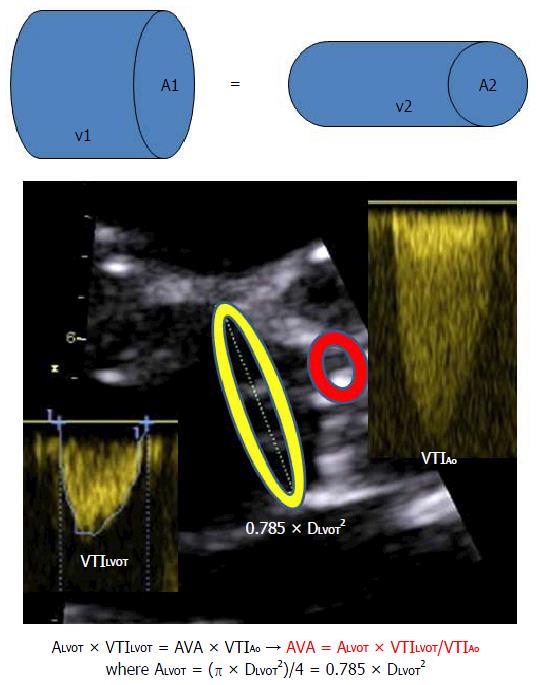Copyright
©The Author(s) 2017.
World J Cardiol. Jun 26, 2017; 9(6): 481-495
Published online Jun 26, 2017. doi: 10.4330/wjc.v9.i6.481
Published online Jun 26, 2017. doi: 10.4330/wjc.v9.i6.481
Figure 1 Relationship between flow, area and velocity.
Calculation of the aortic valve area (AVA) based on the continuity equation. Flow (mL) equals the cross-sectional area (cm2) of the vessel multiplied by the mean flow velocity through that cross-sectional area during a period of time [measured as velocity-time-integral, VTI (cm)]. The flow is constant throughout the length of the vessel without ramifications. Thus, at the aortic valve level, the flow below the valve (in the left ventricular outflow tract, LVOT) equals flow through the aortic valve. Therefore, the AVA equals the LVOT area multiplied by the mean flow velocity through the LVOT area during ejection [LVOT velocity-time-integral, VTILVOT (cm)] divided by the transaortic mean flow velocity during ejection [transaortic velocity-time-integral, VTIAo (cm)]. The LVOT area, given the theoretical circular shape of the LVOT, is calculated by measuring its internal diameter [DLVOT (cm)]. A: Area; V: Velocity; DLVOT: Left ventricular outflow tract diameter; VTI: Velocity-time-integral.
- Citation: Mǎrgulescu AD. Assessment of aortic valve disease - a clinician oriented review. World J Cardiol 2017; 9(6): 481-495
- URL: https://www.wjgnet.com/1949-8462/full/v9/i6/481.htm
- DOI: https://dx.doi.org/10.4330/wjc.v9.i6.481









